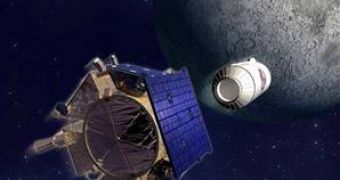Ames Research Center principal investigator Tony Colaprete says that the Lunar Reconnaissance Orbiter which will be launched this year, at the end of October, will also carry a mission designed to study whether there is water on the Moon's poles. The so-called Lunar Crater and Observation Sensing Satellite, or LCROSS, will release the Centaur impactor to crash into the Moon's surface, in a region close to the South Pole. This is the second time in the history of NASA, when the US space agency appeals to such strategies to study the surface of a cosmic body.
In July 2005, the Deep Impact mission impacted the comet's 9P/Tempel nucleus with a body, in order to study its density and composition. NASA believes that there are large amounts of water near Moon's poles as its previous mission, the Lunar Prospector, detected large emissions of hydrogen gas before crashing into a crater near the South Pole. The main goal is to establish what the source of the hydrogen emission is and whether it originates into frozen water deposits under the Moon's surface.
The impactor, Centaur, weighing two tons, will sit on top of the upper stage of the LRO as it will be launched on 28 October with the help of an Atlas 5 rocket. After reaching the Moon's orbit, the impactor will separate from the LRO and will be carried into position by a Shepherding Spacecraft, which, after releasing Centaur towards the designated crater, will have the role of probing the plume ejected from the surface. The Shepherding Spacecraft is equipped with light photometers, an optical camera and another four infrared cameras. With the primary stage of the mission over, the Shepherding Spacecraft will have a similar fate to that of the Lunar Prospector.
The problem is that, for now, NASA has no clue where to put the doomed LCROSS spacecraft, thus they will use the LRO and JAXA's Kaguya orbiter to study the possible crash locations. They hope to find an area deprived of the presence of large rocks, so that the impact will also raise a plume of material to be studied by the LRO spacecraft.
Colaprete argues that the two primary targets will probably be the Faustini and Shoemaker craters which are more like a 3.5 billion years fossil record of the solar system. NASA engineers are confident that there is a 90 percent chance that the two impactors will indeed find evidence of hydrogen near the lunar poles, but there is a small chance that at least one of the two spacecrafts will hit a newly created crater which is poor in water content.
Aside the Deep Impact mission and the crash of the Lunar Prospector, only the European Space Agency has previously crashed a spacecraft onto the surface of the Moon, the Smart-1 satellite which was downed back in 2006. The LCROSS spacecraft is estimated to impact the Moon at a speed of about 2.5 kilometers per second, at a steep angle. The energy released during the impact will probably be 100 larger than that of the crash of the Lunar Prospector, enough to eject up to 1,102 tons of matter into space.

 14 DAY TRIAL //
14 DAY TRIAL //